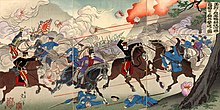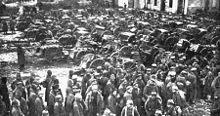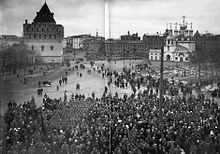World History/The Russian Revolution
Maps | Resources | Contributors' Corner
Background[edit | edit source]
At the turn of the century in 1900 the inexorable slide towards revolution in Russia was already taking place. Russia's economy had started on a rocky road toward capitalism. Though large growth had occurred, it was not sufficiently large enough to advance a nation the size of Russia.
The Russian Social Democratic Labor Party (1900-1903)[edit | edit source]

Vladimir Ilyich Ulyanov, more commonly known by his pseudonym V. I. Lenin, was born into a well-to-do Russian family in Sambirsk, Russia. His elder brother, Alexandar Ulyanov, was executed in May 1887 for an assassination plot against Czar Alexander III. Vladimir was arrested for revolutionary activity that same year, and expelled from Kazan University where he had been studying law. Rather than become a lawyer, Lenin became a Marxist and an advocate of violent revolution against the Czars. In December 1895, he was arrested by the Okrhana and deported to Siberia. He married Nadezdha Krupskaya in July 1889. When his exile ended in 1900, he left Russia and helped to form the Russian Social Democratic Labor Party (RSDLP) among Russian emigrants in Switzerland and started publishing the party newspaper Iskra (The Spark). In 1903, Lenin caused the split of the party into a Bolshevik (Majoritarian) and Menshevik (Minoritarian) factions, which eventually became permanent
The Russo-Japanese War (1904-1905)[edit | edit source]

The Russian Empire, under the Czars, had advanced over the largest territory since the Mongol Empire, encompassing all of modern Russia, Poland, Finland, the Caucasus, Central Asia, and Mongolia. Still, the Czars hungered for more. Under Czar Nicholas II, Russia attempted to expand its influence by occupying the northeastern Chinese province of Manchuria and then turned its greedy eyes toward Korea. However, the Japanese, whose army and navy had been modernized to Western standards, was already in possession of the peninsula. Japan struck first. Its forces quickly routed the Russians, who had hoped to turn an easy victory in the war into a counter-revolutionary propaganda coup. The Russian's Baltic Fleet was sent all the way to the Tsushima Strait between Korea and Japan, only to have all eight battleships destroyed by the Japanese navy in a pitched battle. The war was concluded with a humiliating peace on September 5, 1905, even as Russia was experiencing its Revolution of 1905.
Turmoil and Conflict in Russia (1905-1914)[edit | edit source]
Lenin's Bolsheviks were one of several political parties that developed in Russia during this period. In addition to the Bolsheviks, there were the Social-Revolutionaries, Constitutional-Democrats (Kadets), and Social-Democrats. In Russia, the situation vacillated throughout the period between bad and worse. Peter Stolypin, as Minister of Internal Affairs, acted to try and salvage the situation. A reformist conservative, Stolypin saw the necessity of agrarian reform and attempted to help the peasants situation. In the Czar's court however, people came to see him as a self-interested politician who was gradually losing Nicholas II's favor. In September 1911, he was assassinated by a Socialist-Revolutionary. Very probably, this was the nail that sealed the Czar's coffin, though it wasn't yet apparent.
Lenin's own party was only slightly active during this time. Lenin himself returned to Russia in 1905, but then had to flee yet again when the Okrhana was able to reassert its control. Within Russia, the Bolsheviks operated a newspaper called Pravda (The Truth), which was too much about theory for the tastes of most ordinary Russians. Lenin also was presented with the problem that Marxism traditionally involved a period of capitalist development before socialism and then communism could be achieved. Lenin tried to convince his colleagues that a single stage, violent revolution, could send the country immediately to the socialist stage of development and completely sidestep the so-called "bourgeois-democratic" revolutionary stage.
In 1914, Archduke Franz Ferdinand of Austria was assassinated while taking a parade route through the Bosian provincial capital of Sarajev by a Serbian nationalist. Austria, which produced a set of demands to which Serbia would have to reject, then invaded Serbia before the answer had even arrived. Russia immediately mobilized to help its ally, Serbia. However, because the Russian generals insisted that they had to mobilize all of their troops as their plan called for, troops began to appear on the Russian-German border in Poland. Germany of course told the Russians to stop, but they continued anyway, provoking a German declaration of war. France then declared war on Germany. Germany decided it would be a good idea to invade through neutral Belgium, provoking a British declaration of war against the Central Powers (Germany, Austria-Hungary, and later the Ottoman Empire). Russia simply wasn't ready for a war of such a magnitude. The Russian industrial economy could not stomach the demands put upon it by the war effort. Prices began to rise, as the Russians suffered severe setbacks on the front. Soldiers began to desert. The situation was becoming desperate.
The slide to revolution (1914 - February 1917)[edit | edit source]

The Russians were faced with an impossible situation in the east in 1914. They were expected to defend and attack both the powerful German Reich and the strong Austro-Hungarian Empire. They had the strength to do neither. At the Battle of Tanneburg, 100,000 Russians became prisoners of war and the Germans swept through Poland. At the beginning of the war, however, there was strong support for the war within Russia, as within the other major combatants. However, this turn of events would later turn the people vehemently against the war, which nobody expected to be so bloody or to drag on for four years.
The war situation was acceptable at first. Adequate supplies were available to the troops, however, the urban store houses started to run out of food. Nicholas II's government introduced price controls on grain and other foodstuffs. Rationing quickly became the norm. The thing that really triggered the economic collapse however, was the transportation network, which was woefully inadequate. While the existence of east-west railroads was sufficient, the north-south links were broken and disjointed. Shortages of supplies caused industries to suffer, which caused banks to tighten credit. Each industry aggravated each other's problems. The Czar also continued to repress liberties and freedoms, especially in the Fourth Duma (remember that he had already dismissed it three times).
The situation comes to an abrupt head in February 1917, as strikes broke out on the 22nd at a main armaments plant. Women textile workers began to strike. By the 24th, a city-wide strike had swept the capital city of Petrograd (changed from St. Petersburg to sound less German). Nicholas II took counsel with his advisors, and was told that the situation was untenable.
The February Revolution (February - October 1917)[edit | edit source]

On March 2, the Czar abdicated while traveling by train from the front to Petrograd. Russia literally became a republic overnight. Several prominent Duma members immediately formed a committee to govern the country, which became known as the Provisional Government. The head was to be the Prince Lvov, a relative of the outgoing Czar. The cabinet announced a series of radical social reforms: freedom of speech, faith, assembly, and press. They promised elections for a Constituent Assembly (parliament) by all adults over twenty-one years of age, including women. However, the Provisional Government decided, perhaps fatally, that they would continue the war, which many Russians had already begun to oppose. The Provisional Government should have realized that there was no real hope for governing the country and improving the situation without ending the war. As it was, their insistence on fighting the war immediately made the Provisional Government unpopular. By that time, large-scale mass desertions were occurring on the front and the war was probably untenable for any regime.
The October Revolution (October - November 1917)[edit | edit source]

The October Revolution dated to October 25, 1917 (November 7), also known as the Bolshevik Revolution, was the second phase of the overall Russian Revolution of 1917, after the February Revolution of the same year. The October Revolution overthrew the Russian Provisional Government and gave the power to the Soviets dominated by Bolsheviks.
The Treaty of Brest-Litovsk[edit | edit source]
This was a treaty that prematurely pulled Russia out of WWI before the war had ended. It had harsh economic consequences on Russia and made it ineligible for post-war war talks and treaties.
The Russian Civil War (1918-1921)[edit | edit source]

A civil war fought between the 'Whites' and the 'Reds'. The Whites were against communism and were either capitalists or monarchists. They were also aided by some Western nations who saw them as a way of preventing mass growth of communism in Russia. The reds were pro-communist and fought to establish a permanent communist government, they were called the Bolsheviks. The Bolsheviks won the Russian Civil War.
The New Economic Policy (1921-1924)[edit | edit source]
Lenin's economic policy that was implemented after the failure of "war communism". It allowed limited private ownership of certain businesses and industries and went against the principles of pure communism. Yet, it improved the nation's economic condition and stabilized industry.
The new economic policy could be said to have been the introduction of capitalism back into the economy.
This plan was introduced as an emergency plan to help the Bolsheviks win the civil war. The peasants benefited immensely from the new economic policy and food distribution improved. It also gave people the chance to vote.
Lenin's Legacy[edit | edit source]

Lenin died on January 21, 1924, aged 53. In the four days that the he lay in state, more than 900,000 mourners viewed his body.
Winston Churchill, who encouraged British intervention against the Russian Revolution, in league with the White Movement, to destroy the Bolsheviks and Bolshevism, said:
| “ | He alone could have found the way back to the causeway... The Russian people were left floundering in the bog. Their worst misfortune was his birth... their next worst his death.”[1] | ” |
References[edit | edit source]
- ↑ Mauchline Roberts, Elizabeth, Lenin and the Downfall of Tsarist Russia (1966) p. 92.